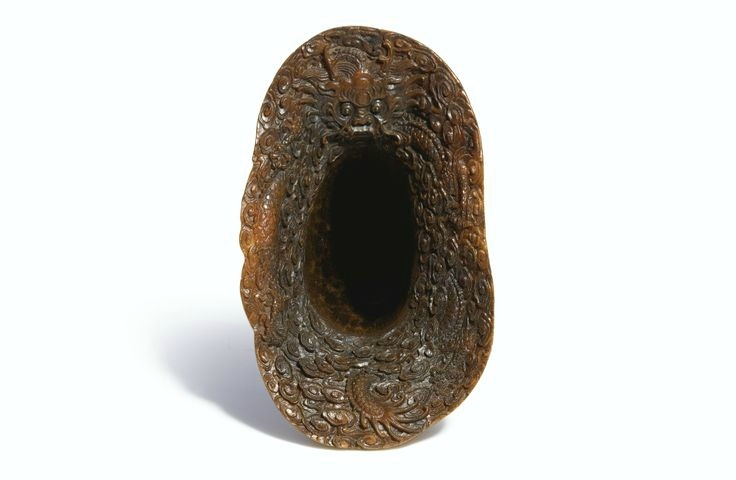A carved rhinoceros horn 'Eight Immortals' cup, Qing dynasty, 17th century
Lot 3009. A carved rhinoceros horn 'Eight Immortals' cup, Qing dynasty, 17th century; length 16 cm., 6 3/8 in. Estimate 2,000,000 — 3,000,000 HKD. Lot sold 3,040,000 HKD. Photo Sotheby's
the exterior deftly carved in openwork and high relief with eight Daoist immortals in loose-fitting robes, some accompanied by their attendants, ascending a craggy mountain with a balustraded pavilion among a variety of leafy trees in a continuous landscape, two of them greeting Shoulao, the God of Longevity seated on a flying crane followed by two further attendents, all beneath scrolling clouds extending to the interior, further carved with a fierce sinuous five-clawed dragon amidst further clouds around the flaring mouth, the horn of variegated brown colour, wood stand.
Provenance: Collection of George Headley.
Exhibited: Metal, Wood, Water, Fire and Earth - Gems of Antiquities Collections in Hong Kong, Hong Kong Museum of Art, 2003-2005, cat. no. 19.
Freer Gallery of Art, Washington DC, Spring 2001.
Literature: Thomas Fok, Connoisseurship of Rhinoceros Horn Carving in China, Hong Kong, 1999, p. 196, pl. 141.
Note: Although rhinoceros horn cups decorated with immortals in a landscape are readily found, the present vessel is highly unusual for its distinctive interior design of a large five-clawed dragon. Only one other rhinoceros horn cup which combines a figural landscape with a dragon motif is known, from the collection of Franklin Chow, sold in these rooms, 8th April 2011, lot 2714. The huge mythical creature is depicted engulfed in swirling clouds with its limbs emerging, to capture a sense of power and dynamism. On the exterior, the immortals occupying the calm and serene world appear blissfully unaware of the majesty of the dragon.
The ‘Eight Daoist Immortals’ is one of the most popular subjects decorating figural rhinoceros horn cups as Daoist adepts originally commissioned the making of vessels in this medium. Here the immortals are depicted gathered around a terrace under the gaze of the God of Immortality, Shoulao, who hovers above on a crane. According to Jan Chapman, The Art of Rhinoceros Horn Carving in China, London, 1999, p. 201, the theme of the Daoist Immortals is represented on rhinoceros horn cups through the use of three distinct techniques as illustrated in three cups from the Chester Beatty Library, Dublin: depicted in the Land of Immortals, carved around the cup in a circle with Shoulao in the centre of the group, and in a natural landscape, all illustrated ibid., pls. 268, 269-70 and 174 respectively. The swirling clouds and mountainous landscape on the present piece capture the ethereal nature of both the land and its inhabitants. The auspicious theme symbolises good fortune and longevity for the vessel’s owner. Shoulao, along with the deer and pine trees, represents longevity, while the flying crane was believed to carry the dead to the Land of Immortals.
A related cup carved with the Eight Immortals, from the collections of Edward T. Chow and Franklin Chow, illustrated in Thomas Fok, Connoisseurship of Rhinoceros Horn Carving in China, Hong Kong, 1999, pl. 142, was sold in these rooms, 8th October 2013, lot 3243. Compare rhinoceros horn cups with similarly carved figural scenes, such as one in the Palace Museum, Beijing, published in The Palace Museum Collection of Elite Carvings, Beijing, 2002, pl. 211; another in the National Palace Museum, Taipei, included in the exhibition Jiangxin yu xiangong. Ming Qing diaoke zhan [Uncanny ingenuity and celestial feats: the carving of Ming and Qing dynasties], National Palace Museum, Taipei, 2011, cat. no. 29; one from the collection of Dr. Ip Yee, illustrated in Dr. Ip Yee, ‘Chinese Rhinoceros Horn Carvings’, International Asian Antiques Fair, Hong Kong, 1982, p. 21, cat. no. 2; and a fourth example from the Edward T. Chow and Franklin Chow collections, sold in these rooms, 8th April 2011, lot 2714.
Sotheby's. Fine Chinese Ceramics and Works of Art, Hong Kong, 08 april 2014

/https%3A%2F%2Fprofilepics.canalblog.com%2Fprofilepics%2F1%2F0%2F100183.jpg)
/https%3A%2F%2Fstorage.canalblog.com%2F03%2F02%2F119589%2F96711876_o.jpg)
/https%3A%2F%2Fstorage.canalblog.com%2F11%2F31%2F119589%2F94773502_o.jpg)
/https%3A%2F%2Fstorage.canalblog.com%2F20%2F83%2F119589%2F94772815_o.jpg)
/https%3A%2F%2Fstorage.canalblog.com%2F26%2F72%2F119589%2F75604929_o.jpg)
/https%3A%2F%2Fstorage.canalblog.com%2F59%2F60%2F119589%2F26458628_o.jpg)





/image%2F1371349%2F20240324%2Fob_e3ecaa_1.jpg)
/image%2F1371349%2F20240324%2Fob_ef0abf_1.jpg)
/image%2F1371349%2F20240324%2Fob_64049b_1.jpg)
/image%2F1371349%2F20240324%2Fob_a0994e_1.jpg)